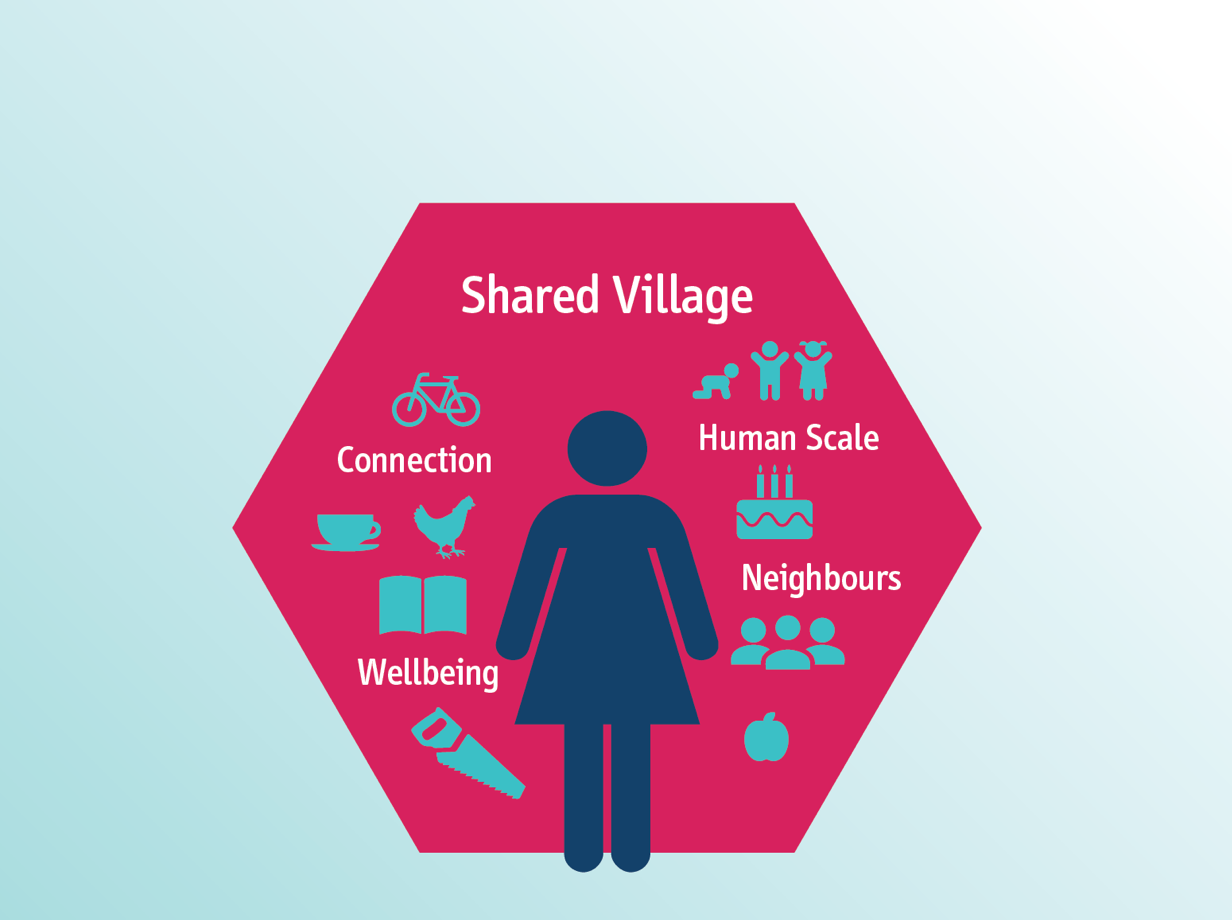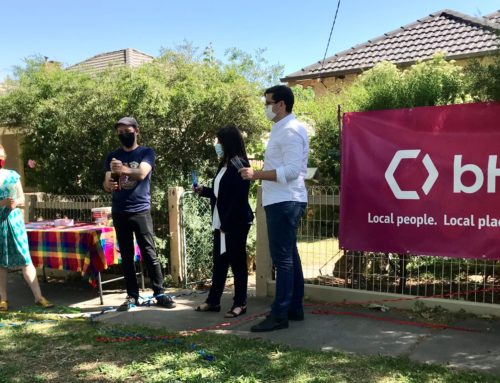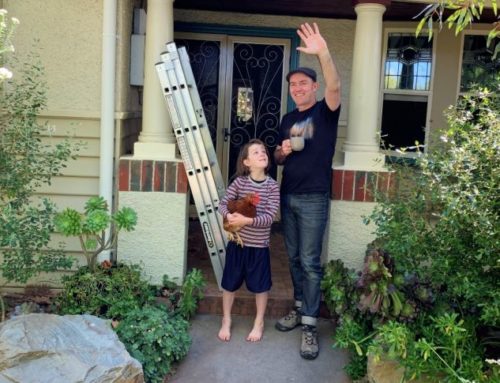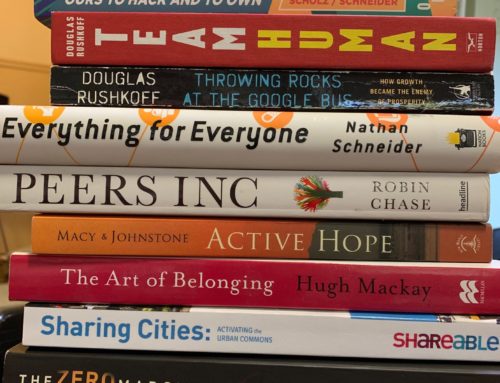The last few months have seen us stuck at home. We’ve had a major interruption to our “normal” lives. There has been great hardship for many people. But there has also been thousands of conversations over the side fence. Many of us have reconnected with our neighbours. For most of human history, our local community have been central to our lives. My grandfather used to sit on the front verandah with a spare chair. The neighbours knew that that chair was for them.
Legendary sociologist Hugh Mackay has been researching Australians for over fifty years. He thinks the death of community in Australia began with the death of the front porch. Studies have shown that as the number of cars on our streets has increased, the number of friends we have on our streets has reduced.
Many of us have been out walking during lockdown and as we do we’ve been chatting to our neighbours. We’ve been looking out for neighbours. Bike sales are through the roof. Maybe it’s time reconnect?
With our Villages Platform, we want to create an epidemic of Belonging. After all, we are supposed to be connected with community.
In his book The Good Life: what makes a life worth living? He argues that the question we all should be asking ourselves is not, “Who am I?” but, “Who are we?” Desmond Tutu put it similarly when he said, “The truth is that we are BECAUSE we belong.” We belong in community and community shapes who we are and who we become and how we influence on the world around us.
When scientists analysed the social networks of all the great ape species, they found that our species, homo sapiens have the largest communities. Throughout history we have had around 150 people in our closest social network. These people are our village (and are not to be confused with Facebook friends, who we may see infrequently in real life).
In the last century these villages have been breaking down as we tend to move house and therefore neighbourhoods and towns and even countries more often. Most of us build houses for single families, more of us live alone. Very few of us sit on the front porch waiting to chat with people as they walk by. Many of us have moved our living areas to the back half of our homes, separating us from our neighbours and village gathering places. Fewer of us are active local citizens, and more of us spend our time buying things online. Social media has led to polarised views. We’re at risk of losing the ability to converse, argue and work together constructively. Across the board, we are now more socially isolated, anxious, depressed and lonely than at any other time in history.
Socially connected people are healthier
Professor Lisa Berkman of the Harvard School of Public Health found that, “People who are socially connected are less likely to die from just about any cause you can think of.” She also found that people with deep social links in their community add ten years to their lifespan and that its better for your health to be socially connected than it is to give up smoking, alcohol and fat.
Stable social connections are crucial from the day we are born. A study of brain scans of three year old children found that brain size in emotionally nurtured children was twice that of neglected children. It wasn’t just size. The part that doesn’t develop when neglected is the prefrontal cortex, the part of the brain where neocortex region of the brain, where all social cognitive processing occurs. We need to be loved and nurtured through close social connections. That connection deeply shapes who we are and the type of influence we have in our communities.
Our social networks shape who we are
Dr Nicholas Christakis, the network scientist, has demonstrated just how connected we are and how our connections shape us. His analysis of the Framlingham Heart Study formed the basis of his book Connected: the surprising power of our social networks and how they shaped our lives. He found that if you have a friend who is happy, you are 45% more likely to be happy. He found that if you friend’s friend is happy, you are 25% more likely to be happy and incredibly, that if your friend’s friend’s friend is happy (think about this, you probably don’t know them!) then you are 10% more likely to be happy. Happiness is influenced to three degrees through our social networks. He found similar links with influence and distance from your house, meaning that a happy person living within 1km of you makes you more happy. He used happiness as an example, but says this hold true for other socially influenced factors like heart disease, smoking or depression.
I sent Nicholas an email to ask how many people we influence in our lives. He replied, “Everything we do effects not just ourselves, not just our friends and families, but tens, sometimes hundreds and possibly thousands of other people.”
What this means is that who we are and what we wear and how healthy we are and what we buy and what we talk about and what we do and how we feel are all contagious. We are constantly being influenced by our social network. And it goes the other way. If we smile at people and say “hi” we can spread friendliness through three degrees of our social networks. If we frown and get angry we can spread that just as far. Think about the person you have been in the last five years and think about the impact that has had on three degrees of your social network. This is an immense responsibility, but it’s also very exciting. We are more powerful than we imagine.
In his 1998 book Bowling Alone, Robert Putnam wrote about social isolation and the breakdown in community in the second half of the 20th century. He identified two types of social connections, Bonding and Bridging. Bonding connections are those that exist within a social grouping, like those within a cricket club. Bridging connections are those that span across social groupings, like the Rotarian who plays cricket, or the Sustainability Group member who is also a CFA member. Bridging connections are very powerful agents of social change as they lead to the spread of new ideas. Bridging connections help to create what’s known as a Small World Network in which influence travels far.
Nature Collaborates and Cooperates
The networked beauty of forests – Suzanne Simard
Social networks have the same structure as ecological systems, with bonding and bridging connections. The connections seen in nature are fascinating and instructive. Biologist Suzanne Simard has been studying the movement of nutrients through forests in Canada and through the underground network of fungi, called the mycorrhizal layer. She found trees at the top of forest collecting sunlight, turning it into sugars and sharing it through the soil with trees in the dark valleys. She found trees in the valleys collecting water and sending it up the hills to the parched trees on top. She found carbon exchange happening across great distances and between species of trees and shrubs. She found trees with wood boring insects releasing a chemical mist that travels through the air in the forest alerting other trees who put up their chemical defences. Simard calls this network the “Wood Wide Web”.
Biomimicry is the practice of learning from 3.8 billion years of design success in nature. For over thirty years, Biomimicry founder and author Janine Benyus has been studying nature and how it might teach us to build more a more effective and fitting civilisation here on earth. Benyus is reviving an old biological debate, thought to be long won by the “survival of the fittest” and “nature competes” philosophy. What we are learning from biomimicry and other ecological studies is that nature collaborates and cooperates for the benefit of the whole system. So my survival is tied up with yours and everyone else’s. It’s a huge comprehension shift for our society as it contradicts the popular worldview that underpins the structure of much of modern politics and business.
We’re hoping that bHive Villages is one tool we can use to reconnect and build a sense of belonging: locally.




